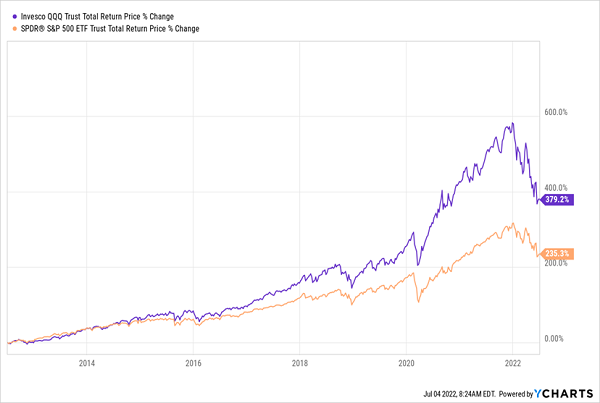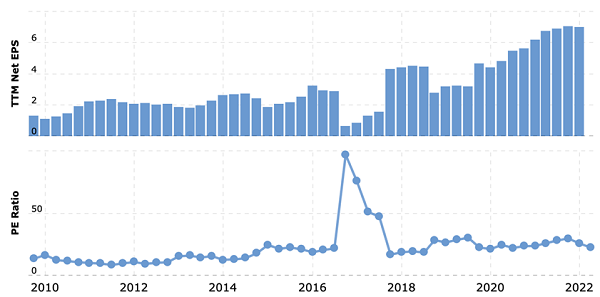After a 30% drop this year, tech is the last sector most folks want to invest in—which makes it a superb hunting ground for us contrarian dividend investors.
Even so, we need to be careful in this Fed-spooked environment, where near-term volatility is certain, so we’re going to hedge our tech investments by focusing on a type of closed-end fund (CEF) that gives us the following:
- An outsized 8%+ dividend that can see us through rough markets without having to sell shares, and …
- The ability to actually profit when markets get rough.
We get both of these rare strengths in the Nuveen Nasdaq 100 Dynamic Overwrite Fund (QQQX), a CEF whose vitals we’ll delve into in a bit.
Let’s talk a little more about tech first—specifically its performance over the long haul. Because while caution is warranted in the short run, there are many reasons to be bullish in the long term, including history.
As you can see below, tech, shown by the performance of the NASDAQ benchmark Invesco QQQ Trust (QQQ), in purple below, has outperformed the S&P 500 benchmark ETF, in orange, over the last decade:
Tech Stocks Outrun All Other Sectors in the Long Haul

I expect that trend to continue, making a buy now, especially through a high-dividend “hedged” fund like QQQX, a smart move.
Consider also that, with a 30% decline from its all-time high, the NASDAQ 100 has now fallen even further from its all-time high than it did at the bleakest point of the COVID-19 pandemic, long before vaccines, effective medicines or even any idea of when lockdowns would end.
That’s absurd, considering that we’re all using products and services from Apple (AAPL), Amazon (AMZN), Google (GOOG) and Microsoft (MSFT) more than ever. Obviously, the Federal Reserve is a big part of the story here, but it isn’t the whole story. Because in recent days, we’ve seen tech starting to stabilize, which makes sense when you look at the fundamentals.
The Best Companies at the Lowest Prices

Source: Macrotrends.net
Investors appear to be slowly realizing that the NASDAQ is too cheap, with a P/E ratio of 22.3 (second chart above), despite the fact that earnings per share are growing at a 13% rate. Likewise, the NASDAQ 100’s P/E ratio is closer to that of the S&P 500 (which is around 19.3) than it has been in years, even though NASDAQ companies are posting faster earnings growth than the S&P’s more humble 4.1% growth rate.
So while everyone is getting in a stir over the Fed and inflation, which are serious issues in the short term, they are throwing the baby out with the bathwater and selling very good companies that are cornerstones of the modern economy.
How to Profit From Short-Term Tech Volatility—and Get Set for Long-Term Gains
Now let’s swing back to QQQX, because it can give you the large cap tech companies in the NASDAQ at a nice “selloff discount” of around 30%, along with a bit of downside protection and a hefty 8.9% income stream.
A good portion of that income stream, along with that decrease in volatility, comes from the fact that QQQX sells call options on its holdings, and the fund holds the entirety of the NASDAQ 100. Those options give QQQX an income stream that it passes on to investors—and that income stream is directly tied to volatility, because the more volatile the market, the more willing traders are to pay up for those options.
Here’s how it works: QQQX’s management sells call options, which are basically contracts under which the fund sells the right to buy its stocks to another investor at a fixed share price in exchange for a cash payment, known as a premium. This gives the seller protection from a downturn, since they get to keep the premium no matter what happens, and the option expires if the stock falls below the set price.
If the stock rises above that price, it gets sold, or “called away.” That can cap the fund’s upside, as it will inevitably sell strong performers, but the fund does get to keep the premium.
This strategy makes now a good time to take a close look at QQQX as a way to play short-term volatility in the market, then, over the long run, switch over to a “pure” tech CEF as the sector bottoms and (inevitably) begins another upswing.
Our Recession-Survival Plan: 5 Monthly Payers Yielding 7.9%
QQQX is just the kind of fund we want to focus on in a market like this because it gives us the income we need to get through to the other side—and nicely prepares us for strong capital gains when we do!
This is the beauty of investing in CEFs. And there’s another advantage: many CEFs pay you dividends every single month, right in line with your bills!
That’s a lifesaver these days, because it saves you from having to manage a “lumpy” income stream. You always know your dividend income, right down to the penny, month in and month out.
I’ve assembled my very best monthly dividend CEF picks in a new report I want to give you access to right here. It contains full details on these sturdy funds, which yield 7.9% as I write this and trade at outsized discounts, too!
This Special Investor Report, containing the names, tickers, and my analysis of each of these 5 high-yielding CEFs, is waiting for you now. Click here and I’ll tell you more about my CEF investing strategy and show you how to get instant access to your copy of this breakthrough report.

Recent Comments